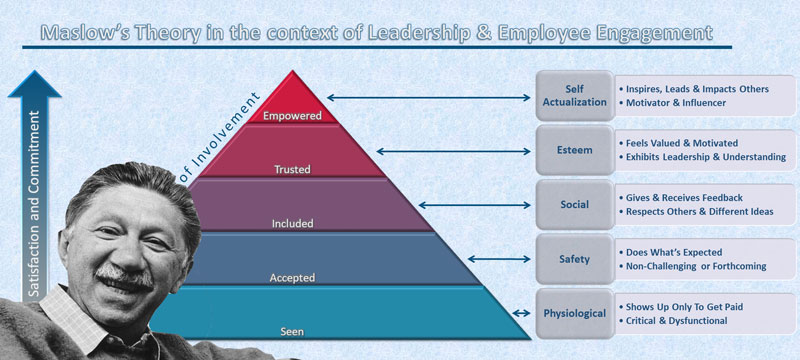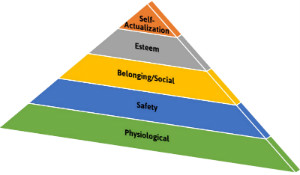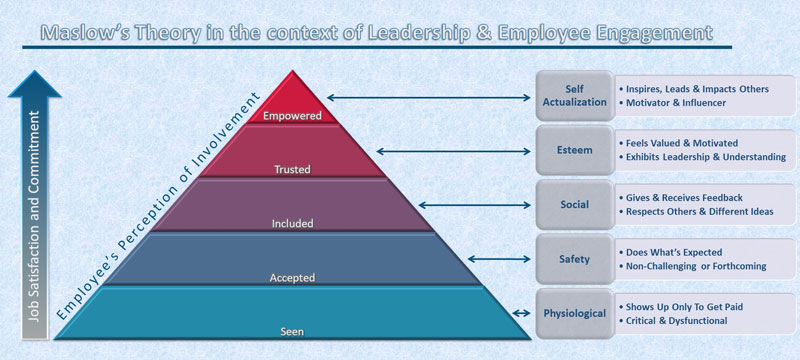![]()
 In 1943, Abraham Maslow first introduced his Hierarchy of Needs theory, which examines what motivates individuals.
In 1943, Abraham Maslow first introduced his Hierarchy of Needs theory, which examines what motivates individuals.
He claimed that people are motivated by things and circumstances ranging from basic survival to the ability to reach and achieve one's full potential.
That sounds like something that could be applied in the workplace to elevate employees' motivation from simply being there to get a paycheck to performing at a very high level.
...and actually, enjoy doing it.
 Usually depicted by the pyramid on the right, Maslow's human psychological needs are
Usually depicted by the pyramid on the right, Maslow's human psychological needs are
- Physiological – air, food, shelter, sleep, etc...
- Safety – security, order, law, stability, etc...
- Belonging/Social – family, affection, friends, relationships, etc...
- Esteem – achievement, recognition, independence, responsibility, etc...
- Self-Actualization – realizing potential, self-fulfillment, seeking growth, peak experiences, etc...
It is possible to take each of these high-level essentials and transpose them into an employee-centric model to increase employee engagement and facilitate leadership development.
The graphic and narrative below show how Maslow's five tiers can be mapped to five mindsets that individual employees (and, by association, their teams) can be encouraged to strive for in the workplace.
Click image to Download the Original, Hi-Res Version
PHYSIOLOGICAL → SEEN
Highly disengaged and dissatisfied employees don't feel part of anything, have minimal commitment, and are usually only there to be seen and collect a paycheck – after all, that is a basic requirement with any job. Because they have no emotional connection, they usually take more days off, probably don't like their boss, are disingenuous to their colleagues, and would likely jump at the chance of a new job. In extreme cases, they may be purposely hurting the business.
Much of this disengagement can be remedied by finding out the employee's pain points.
Perhaps they don't think their contribution is valued, or there is perpetual conflict within their team, or there is no opportunity to express themselves.
SAFETY → ACCEPTED
An individual who can begin building better working relationships with their boss and co-workers will start to feel accepted at work—but only so far as getting the job done. They may still be hesitant to come forward with ideas and suggestions because they feel their input will not matter or (even worse) be scoffed at.
Getting beyond this need/mindset is usually a big step as it involves a commitment to gauging and improving levels of openness, motivation, feedback, and more at the individual and team levels.
SOCIAL → INCLUDED
When we begin to feel included, we open up to others and their differing opinions, traits, and skills. We communicate with each other in a manner that the other party is comfortable with and doesn't feel threatened by. This fosters a culture of proactive feedback, not just between the boss and the employee but also throughout the team.
At this point, the unit starts working well together, harnessing differences in the pursuit of outcomes and solutions that deliver projects successfully, improve sales quotas, elevate customer service levels, etc...
ESTEEM → TRUSTED
As employees begin to feel more valued by leadership and peers, their levels of self-esteem and trust in those around them increases dramatically. There is an ethos of openness among the team, and management understands the individual motivators of each employee (some like to work alone while others prefer the hustle of working in a group, and while one person may like public recognition, another might prefer a private 'thank-you' moment)
High levels of belief (in self, team members, and management) drives motivation, which in turn powers increased performance. Individuals now start exhibiting leadership traits as they inspire those around them – purposely and subconsciously.
SELF-ACTUALIZATION → EMPOWERED
Top-of-the-pyramid performers want to be empowered to act independently and have their actions influence and inspire others. They seek opportunities to better themselves and those around them for individual and team success.
They may not necessarily need to be put in a 'position' of leadership, but because they both trust and are trusted, they are seen as leaders within the organization.
Successful teams and organizations are rife with leaders...not in the sense of a job title but through an engaged culture and by the way things get done.
- - - - -
There are many models, theories, and the like that can be applied to individuals, teams, and organizations seeking to improve leadership and engagement. The most important thing is to systematically measure and improve what is important to your individuals, teams, and organization.
The one underlying element in any of these improvement initiatives is that it is focused on and is driven by a sense of belonging and relationships...which ironically is right at the halfway point in Maslow's hierarchy \_(ツ)_/
